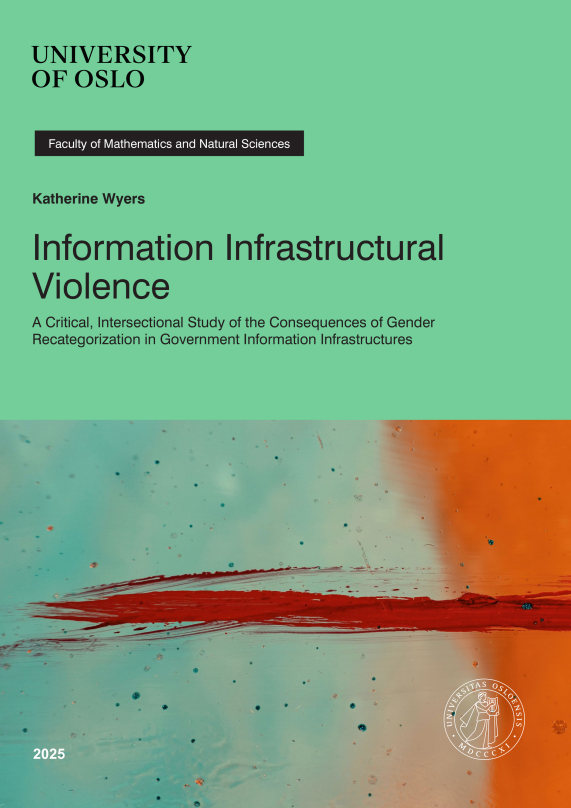Information Infrastructural Violence: A Critical, Intersectional Study of Gender Recategorization in Government Information Infrastructure
Katherine Wyers, Dept. of Informatics, University of Oslo
Link to PhD Disputation at University of Oslo: https://www.mn.uio.no/ifi/forskning/aktuelt/arrangementer/disputaser/2025/Wyers.html
Theoretical Framework and Methods
- Ethnographic Methods
- Infrastructure Theory
- Intersectionality
- Structural Violence
- Critical Research
- Identity and Categories
Empirical Case
- Transgender and Gender Diverse People
- North India
- Lived Experiences during Recategorization
- Government Recategorization
Findings and Contribution
A slow-changing government information infrastructure can have violent consequences on the daily life of an individual, especially if they are disadvantaged by racism, sexism, ableism, or other structural systems of oppression.
Introducing the Collateral Burden construct

Whether in delays to healthcare provision, or suspicion at border crossings, identity categories shape our lives and can have an adverse effect on those who are deemed to fall outside or transgress the identity categories. Despite their significance, there is relatively little known within the information systems (IS) discipline about the consequences of identity recategorization. This is particularly concerning at present, because the contestations surrounding categories of race, gender, nationality, and other identity categories play such a central role in many of the debates in public and private sector organizations, where the consequences of these categories and their recategorization can adversely shape many aspects of a person’s daily life.
From a technical perspective, information infrastructures (IIs) are composed of various classification systems, protocols, and technical specifications that codify the rules and procedures for interaction between a system’s elements (Turner et al., 2006, p. 94). However, IIs are fundamentally a relational concept (Star & Ruhleder, 1996). They are engines of ontological change that stand between people, technology, and nature, reinforcing each simultaneously (Karasti et al., 2018, p. 271). As the requirements for the classifications change, these IIs need to be changed so they remain aligned. Without this process of change, the systems relying on the infrastructure would seize up and no longer function as needed, becoming stiff and unworkable (Jackson, 2014, p. 223).
Identity categories are not merely neutral, objective representations of reality. They are often sites of political and social struggles (Bowker & Star, 1999). This political struggle can become firmly entrenched into the working infrastructure when II evolution involves the integration of identity category changes, and this has moral and ethical implications. Identity categories have material effects on the lives of the people they target (Beaudevin & Schramm, 2019) and when created or changed by the State, identity claims by individuals can be subverted, or individuals can feel their rights to self-definition are impinged upon (Yanow, 2003). For those who are disadvantaged by such changes, the infrastructure can have a detrimental impact on their lives (Bowker & Star, 1999).
This study seeks to understand the consequences of making changes to an identity category in a government II. It explores the case of India’s gender category, which in 2014 was expanded from legally recognizing two genders, {male, female}, to recognizing three genders, {male, female, transgender}. This change was introduced by the Indian Supreme Court to legally recognize India’s transgender community, a change that came with concomitant updates to the II.
Grounded in post-structuralism and critical interpretivism, this study drew on three months of ethnographic fieldwork conducted in the rural north Indian state of Himachal Pradesh, and the urban center of Delhi. The data comprised of 28 semi-structured interviews with transgender and gender diverse (TGD) people, bureaucrats, and members of civil society, together with a focus group discussion, and document analysis from the period 2014 to 2024. The findings were triangulated with fieldnotes from the three months of fieldwork.
The thesis presents five research papers. Paper 1 explores methodologies used when studying the relationship between TGD people and information systems, encouraging critical feminist methodologies and deep engagement with the research context. Paper 2 explores the consequences of identity recategorization with regards to cross-disciplinary collaboration during periods of II evolution, finding conflict and resistance to the loose definition of identity categories. Paper 3 shows how IS use has been shaped at the street level of policy implementation, and the emergence of identity stereotyping during recategorization. Paper 4 illustrates how the lived experiences of TGD people have been shaped by the recategorization of their identities within the government II and shows how they navigate their identities during the period of evolution. Paper 5 explores the ontological foundations of identity representation in organizational data and argues for a rethinking of the enumerative approach that is typically used to represent identities in data. This thesis then discusses these findings with regards to burden, power differentials, and slow change. From this, the thesis proposes an extension to II theory using intersectionality, structural violence, and slow violence and presents the collateral burden construct to represent the burden placed on the shoulders of the individuals during information infrastructural change.
This study makes several theoretical, methodological, and practical contributions. It makes theoretical contributions by proposing an expansion to II theory based on empirical analysis to consider the relationship between the slow changing temporality of IIs and the everyday lives of individuals. It shows the high level of hidden work that takes place during such a period of II evolution. It explores the potential risk of the installed base harboring systemic bias, and discusses how nations with a post-colonial history, or a history of racism, sexism, or ableism can have an installed base that can harbor biases in need of interrogation. The study makes practical contributions by showing the potential negative consequences of a change to an identity category and highlights key areas where plans can be made to mitigate these consequences during the process of identity category change. The study contributes to the communities of the participants by amplifying the voices of India’s transgender and gender diverse people from a wide range of gender identities and expressions. It also highlights the crucial work performed by advocacy groups and civil society members during the change process.
Keywords: Government information infrastructures, identity categories, intersectionality, structural violence, transgender, India.
